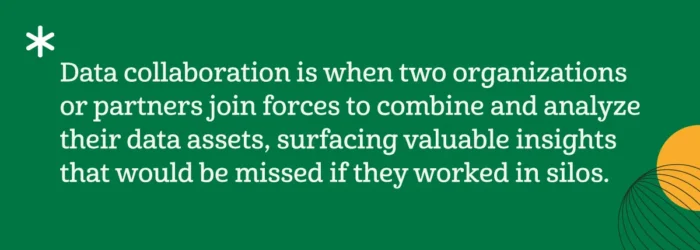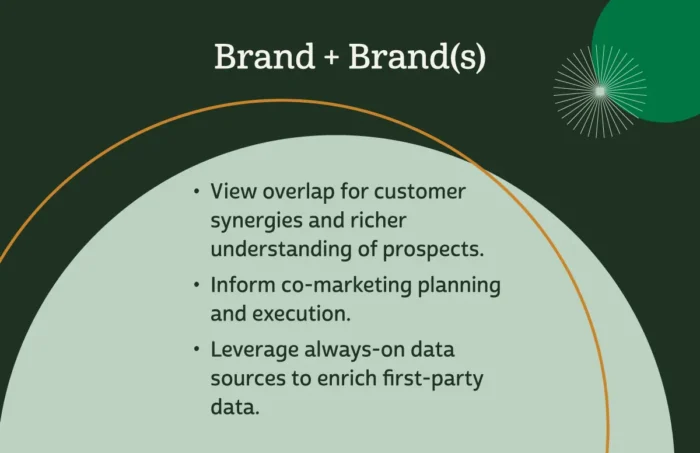In our data-driven world, digital marketers are leaning hard on insights from customer information to shape decisions, strategies, and engagement. But simply having data isn’t enough. Businesses need to collaborate and share data to truly unlock its potential. This allows them to gain new perspectives, improve products and services, and drive sustainable growth.
This guide delves into the best practices for data collaboration, offering a roadmap for forging powerful partnerships and preserving connectivity in a world without third-party cookies.
Understanding Data Collaboration
Data collaboration is when two organizations or partners join forces to combine and analyze their data assets, surfacing valuable insights that would be missed if they worked in silos.
According to the IAB, data collaboration can be defined as the use of technology to combine and analyze data sets within an organization or with partners to enable a wide range of use cases, from uncovering new consumer insights and enabling accurate cross-screen measurement to expanding reach and creating brand-building media networks.

At its core, it’s about different stakeholders — whether within the same company or across different companies — coming together to permission data with the goal of extracting insights to fuel marketing strategies. You see this playing out across industries, as companies use collaboration to break down data silos, fuel business intelligence, and spark overall innovation.
Key Drivers
With data privacy laws tightening and third-party cookies going away, data collaboration is essential for digital marketers to make the most oftheir data, all while navigating a new landscape.
The rise of data collaboration has been propelled by the demand for scaled, diverse data sets, the push to make data-driven decisions, and the challenges created by organizational silos. Collaborating allows companies to combine their collective insights to better steer strategy and understand customers.
The Importance of First-Party Data
First-party data refers to information obtained directly from your audience or customers. This includes data collected from sources such as:
- Interactions on Your Website
- Social Media Engagement
- Customer Feedback Surveys
- Transactions
The direct connection between the collector (business) and the source (customer or audience) ensures a higher level of accuracy and relevance, making first-party data extremely valuable.
Finding ways to increase the value of your first-party data is becoming more and more important as third-party cookies disappear. By uncovering direct insights into customer behavior, preferences, and feedback, businesses can tailor their products, services, and marketing strategies to meet the precise needs of their target audience. This customization enhances customer experience, boosts loyalty, and drives conversion rates. Best of all, no third-party cookies are required.
Comparing Data Sources
- First-Party Data: Data you collect directly from your customers and audiences. Accuracy and relevance are its core advantages.
- Second-Party Data: Essentially someone else’s first-party data that you get through a direct business partnership or agreement to share certain datasets.
- Third-Party Data: This is data aggregated from multiple sources by an outside entity with no direct relationship to those customers. It can help provide scale and enrich first-party data with additional insights.
7 Best Practices for Data Collaboration
External data collaboration represents a paradigm shift in how organizations approach second-party data and analysis. Through collaboration, companies can unlock new insights, enhance customer experiences, and drive innovation. However, embarking on a data collaboration initiative requires careful planning and execution.
1. Set Clear Objectives, Goals and Timelines
Here’s how organizations can set realistic expectations and ensure the success of their data collaboration efforts.
Identifying Objectives for Data Collaboration
Before initiating a data collaboration project, it’s crucial to define clear and measurable objectives. Whether it’s enhancing customer insights, developing new products, or improving marketing strategies, having a clear understanding of what you aim to achieve helps guide the selection of partners, data, and technologies.
Aligning Data Collaboration Goals with Overall Business Strategy
Ensure that your data collaboration efforts align with your broader business strategy. This alignment helps to secure buy-in from stakeholders across the organization and ensures that the collaboration drives value towards achieving overarching business goals.
Setting Timelines for Sending and/or Receiving Data
Timelines are essential for managing expectations and ensuring the smooth execution of data collaboration projects. Establish realistic timelines for the exchange of data, analysis, and the implementation of insights. Factor in potential delays and build in time for thorough analysis before utilizing insights for campaigns or strategy sessions.
2. Data Collaboration Platform Considerations

Selecting an appropriate data collaboration platform is a critical decision that requires careful consideration of various factors to ensure the success of your data initiatives. Here are several factors you should consider:
- Activation: Evaluate whether the platform empowers you to effectively utilize the data. Opt for a tool that enables seamless activation and modeling, ensuring meaningful engagement with your datasets.
- Compatibility: It should integrate seamlessly with your existing systems and facilitate easy, secure data exchange with potential partners.
- Flexibility: Maximize the potential of data collaboration by selecting a platform that can accept both known (deterministic) and unknown (probabilistic or inferred) data. This approach ensures a broader and more inclusive data linking capability, uncovering insights that might otherwise remain hidden.
Overview of Popular Platforms and Tools
The clean room landscape showcases various types of data collaboration platforms, each catering to different needs:
- Data Warehouse Cleanrooms: Typically, these platforms are designed for organizations that need to maintain large-scale data warehouses with clean room capabilities for secure, in-depth analysis.
- Walled Garden Clean Rooms: These are provided by large tech companies and are can be suitable for marketers looking to combine their first-party data with consumer data within the partner’s ecosystem.
- Data Collaboration Platforms: These platforms can allow for private data sharing and enrichment, and are ideal for companies looking for flexible collaboration without the necessity of moving data out of their environments.
- Query Clean Rooms: This option can offer a neutral ground for data collaboration, especially useful for parties looking to utilize their first-party datasets in a secure, privacy-compliant manner without data movement.
3. Choose the Right Data Collaboration Partner
Once you’ve decided what data collaboration platform or technology you will use, it’s time to choose the partner you will collaborate with.
Questions for Ensuring a Good Fit with a Data Collaboration Partner
Use the following questions to help you determine the right partner for your collaboration.
- Data Housing: Ask where the partner’s data is stored and the security measures in place.
- Data Movement: Clarify the process for data transfer, if necessary, and how it will be secured.
- Data Overlap: Determine the extent of overlap between your datasets and the potential value it could bring to both parties.
- ID Availability: Inquire about available identifiers for data matching and whether an identity graph is available or can be created.
- Data Uniqueness: Evaluate how unique and complementary the partner’s data is to your strategy.
Assessing the Value of a Data Collaboration Exercise
- Overlap Threshold: Establish what level of overlap makes sense. For example, at Lotame, we consider 5,000 unique attributes our benchmark to justify a collaboration effort.
- Data Strategy Enhancement: Consider if the partner’s data will provide insights that are additive to your current strategy and how it will impact your campaign or targeting strategy.
Additional Tips for Selecting a Marketer or Publisher Partner
- Unique Data: The partner’s data should offer something unique that you do not already possess.
- Strategic Alignment: Their data should align with and enhance your marketing or publishing goals.
- Additive Insights: The collaboration should enable both parties to deliver better campaigns, targeting strategies, or general insights that neither could achieve independently.
4. Share Data Collection Documentation
Now that you have chosen the appropriate partner to collaborate with, it’s time to get into the nitty-gritty. First, you should share with your partner how the data will be collected. Provide clear descriptions of how the data is sourced, highlighting what makes the data unique. The Lotame Data Exchange’s newest taxonomy focuses on data sources, like contextual consumption, location, transactional, and survey-based, to easily analyze what people read, where they spend their time, and what they spend their money on, as examples.
5. Categorize Data
Next, it’s time to categorize the data. Group data into meaningful categories (demographics, interests, buyer propensity) for easier analysis and targeting. High-level categories are helpful for broad and quick analysis, but typically more meaningful data is found in the lower-level interests within taxonomies and these should be formatted in a way to easily extract insights.
6. Facilitate Visualizations
Organize data in multiple levels to easily generate insightful charts and reports (i.e., using pivot tables) for partners. Data analysis charts are often organized by taxonomy source (ex. contextual or keywords), customer types (ex. loyalists or high spenders), or personas. These can all inform a more well-rounded recommendation from a media placement, creative strategy, or audience target perspective.
7. Remove Irrelevant Data Points
Identify and exclude information not relevant for collaboration. Data specific to other brands or use cases may create noise for some partners.
Examples of Data Collaboration Partnerships

Data collaboration platforms are an emerging technology within the marketing technology ecosystem. A subset of data collaboration is clean room point solutions. They have been making headlines as a way for companies to work together in a highly controlled manner to join and analyze data in a privacy-compliant way. However, clean rooms are just one option for data collaboration. They may not be appropriate or accessible for all use cases, so you may want to explore all available options for collaboration before making a decision.
Below are some common collaboration scenarios to help inform partnerships and campaign planning with built-in data clean room technology:
Brand + Brand(s)
- View overlap for customer synergies and richer understanding of prospects.
- Inform co-marketing planning and execution.
- Leverage always-on data sources to enrich first-party data.
Publisher(s) + Brand(s)
- Use overlap to discover and inform content category alignment and real-time audience reach.
- Create new audiences for analytics and cookieless targeting.
- Monetize consumer base with audience or contextual activation across all screens.
Agency + Data Source(s)
- Model first-party seed data for scaled analytics and addressability.
- Create data networks across clients using various sources to uncover commonalities for analysis and targeting.
- Provide provisioning and access controls that partners and brands require
Lotame’s Data Collaboration Solution
Lotame’s end-to-end data collaboration platform, Spherical empowers marketers and media owners to unite, analyze, and activate first-party data in smarter, faster and easier ways. With our technology, you can connect the dots between different pools of audience data with both internal and external partners to generate actionable insights, data-driven audiences, and identity-powered activation. Gain everything you need to know about your consumers to power your company’s innovation and help hit revenue goals. Contact us today to learn more.
This post was written by Lotame’s VP of Consumer Intelligence & Analytics, Kristen Whitmore.